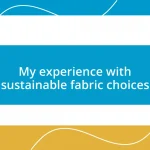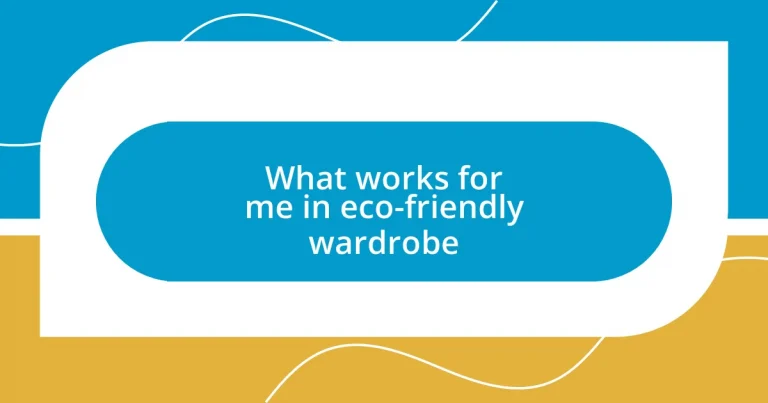Key takeaways:
- Embraced slow fashion by curating a personal wardrobe of high-quality, meaningful pieces.
- Focused on selecting ethical brands based on transparency, sustainable materials, and fair labor practices.
- Adopted eco-friendly laundry practices and maintenance techniques to extend the lifespan of clothing and reduce environmental impact.

Understanding eco-friendly fashion choices
When I first stumbled upon eco-friendly fashion, the sheer variety of materials and processes blew me away. I remember finding a pair of jeans made from organic cotton; the moment I touched the fabric, I realized it felt just as good, if not better, than traditional options. Isn’t it fascinating how sustainable choices can offer both quality and care for our planet?
As I dug deeper, I encountered the concept of slow fashion, which turned my shopping habits upside down. I began to ask myself, “What if I invested in fewer, high-quality pieces that truly resonate with my personal style?” This shift not only lightened my closet but also created a stronger emotional connection to each item I owned, making me more intentional about what I wear.
Exploring second-hand shops opened a whole new dialogue in my journey. The thrill of discovering a vintage piece felt like unraveling a story—each wear carries its history. Have you ever pondered who wore that unique dress before you? There’s something beautifully poetic about giving life to garments that might have otherwise been discarded.

Building a sustainable wardrobe foundation
Building a sustainable wardrobe foundation starts with understanding the core of your personal style. One day, while sorting through my closet, I realized that I had a few pieces I loved to wear, while others merely filled space. I decided to keep only what felt right—those pieces that truly represented me—leading to a more curated and intentional wardrobe. It’s liberating to wear items that reflect who I am and promote sustainability at the same time.
When considering sustainable options, the fabric choice matters immensely. I still recall the first time I switched to clothes made from Tencel, a biodegradable material derived from wood pulp. The soft drape and breathable nature of the fabric were a game changer. Realizing that such choices not only serve my comfort but also lessen my environmental impact makes shopping feel more meaningful. Each time I wear something made from eco-friendly materials, I find joy in knowing I’m making a positive choice.
Building a sustainable foundation isn’t just about material choices; it’s about embracing a mindset shift. I’ve learned to appreciate the value of repairing instead of discarding. The first time I patched a pair of my favorite trousers, I felt a sense of pride and accomplishment. It sparks happiness to breathe new life into a cherished piece. Have you ever experienced that satisfaction of mending something instead of buying a new one? It’s a small act that contributes to a larger goal of sustainability.
| Sustainable Choices | Personal Experience |
|---|---|
| Curating a Wardrobe | Kept only pieces that resonate with me. |
| Fabric Awareness | Switched to Tencel and loved the feel. |
| Embracing Repair | Patching trousers brought pride and joy. |

Selecting ethical clothing brands
When selecting ethical clothing brands, I often place a strong emphasis on transparency. I remember sending an email to a brand asking about their sourcing practices. When they responded promptly with detailed information about where their materials come from and their production processes, I felt a genuine connection to their mission. Knowing that a brand is willing to share its story and values with consumers makes choosing to support them a more thoughtful decision.
Here are some key factors I consider when selecting ethical brands:
- Transparency: Brands should openly share information about their sourcing and production.
- Sustainable Materials: Look for fabrics like organic cotton, Tencel, or recycled materials.
- Fair Labor Practices: Ensure the brand supports ethical working conditions and fair wages.
- Local Production: I find that brands producing locally often have a smaller carbon footprint.
- Certifications: Certifications like GOTS (Global Organic Textile Standard) and Fair Trade can be reassuring indicators of ethical practices.
For me, it’s more than just shopping—it’s a way to support a bigger cause, fostering a positive emotional connection with each piece I choose. Whenever I wear something from an ethical brand, it feels like I’m not just dressing myself but also aligning with a belief in a better world. There’s an undeniable satisfaction that comes from knowing that my clothing choices can contribute to meaningful change.

Incorporating recycled materials into outfits
Incorporating recycled materials into my outfits has been a delightful journey toward sustainability. I recently bought a jacket made entirely from recycled plastic bottles. The moment I slipped it on, I marveled at how something once discarded could be transformed into such a stylish and functional piece. It made me wonder: what else can we repurpose that might otherwise waste away in landfills?
One fantastic experience I had was discovering a local brand that specializes in clothing made from upcycled materials. I found a stunning dress that had been created from leftover fabrics from previous collections. Not only did the unique pattern stand out, but it was also a conversation starter at every event I wore it. Have you ever worn something that sparked a discussion about sustainability? Those moments make me feel like I’m playing a small part in a much larger movement.
I firmly believe that outfits made from recycled materials can be chic and innovative. Last summer, I stumbled upon a pair of sneakers crafted from fishing nets collected from the ocean. I can still remember how I felt walking in them—proud and connected to a cause. The visual impact of wearing something that helps reduce ocean waste is just incredible. So, next time you’re shopping, why not look for pieces that tell a story of repurposing? It adds depth to your wardrobe and your personal journey toward sustainability.

Organizing a versatile capsule wardrobe
Organizing a versatile capsule wardrobe requires a bit of strategy, but it can be immensely rewarding. I remember when I first simplified my closet, choosing pieces that I truly loved and that worked well together. The relief of decluttering was palpable; I felt lighter and more focused, as each item represented not just a choice, but a thoughtful decision. Isn’t it satisfying to have a wardrobe where each piece reflects your style and values?
One approach that worked well for me was categorizing items by type and color, creating a palette that makes mixing and matching effortless. I was surprised at how many outfits I could create with just a few key pieces—like a classic black dress that transitions seamlessly from work to evening events. Seeing those options laid out brought about a creative spark! Have you found that visual organization fuels your creativity?
I also found that investing in timeless, high-quality pieces pays off in the long run. For instance, a good trench coat can be dressed up or down, while a versatile pair of shoes can carry you through countless occasions. Each time I step out in my thoughtfully arranged wardrobe, I feel empowered and ready to tackle the day. It’s incredible how a little organization can transform not only your closet but also your mindset about fashion!

Tips for eco-friendly laundry practices
I’ve learned that adopting eco-friendly laundry practices can make a significant difference in reducing my environmental footprint. For instance, I started washing my clothes in cold water instead of hot. Not only does it save energy, but I’ve also been pleasantly surprised to see that my clothes don’t lose their vibrancy or fit. Have you ever tried making that small switch?
Another tip that really transformed my laundry routine is air drying my clothes. I remember the first time I hung my favorite sweater on a line outside. It felt like a refreshing change, not just for the planet but for my wardrobe as well. There’s something special about wearing clothes that have been kissed by the sun. Plus, I’ve noticed they often last longer without the wear and tear of a dryer.
Lastly, I swapped out conventional laundry detergents for eco-friendly options made with natural ingredients. I was initially skeptical about whether they could match the cleaning power I was used to. However, after experimenting for a few weeks, I realized my clothes still came out clean and fresh, and with far less chemical residue. This small change made me feel so much better about what I was putting down the drain. How amazing is it to contribute to a healthier planet with the simple act of doing laundry?

Maintaining clothing to extend lifespan
Maintaining clothing is an art that can really enhance their lifespan. I recall the moment I discovered the power of spot cleaning. Instead of throwing a loved shirt in the wash every time it had a little spill, I learned to treat those stains immediately with some gentle soap and water. This not only preserved the fabric but also kept my clothes looking fresh longer. Have you ever tried this simple yet effective method?
Investing in proper storage has also made a world of difference for me. When I started using breathable garment bags instead of plastic, I noticed how my delicate fabrics remained intact without scents or fading. I remember opening my winter sweaters after a season in storage and being pleasantly surprised that they looked brand new. What’s better than rediscovering hidden treasures in your closet that still make your heart flutter?
Lastly, I make it a habit to check care labels before washing, and it has been a game-changer. I learned the hard way a few times by ignoring that advice—only to have a favorite shirt shrink unexpectedly. Now, I take a few moments to ensure I’m following the specific guidelines. It’s a small step, but it’s helped me maintain my wardrobe effectively. Isn’t it rewarding to keep our clothes looking and feeling their best?












